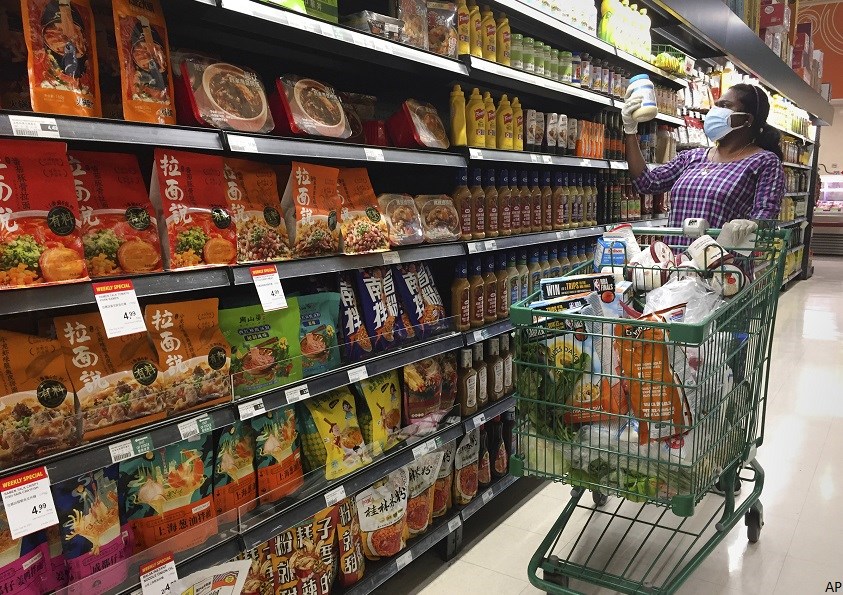
Recent readings of inflation are high practically everywhere. In Canada, inflation is currently hovering near 4.7%, in the United States, at 6.2%. Most major economies in Europe also see inflation rising: the rates in the U.K. are at 4.2%, Germany at 4.5%, Spain at 5.4%. IN the east, China seems to be somewhat insulated, with inflation near 1.5%, but South Korean inflation is at around 3.2%. Japan meanwhile continues to be an outlier, continuing its decades-long flirt with deflation at 0.1%.
“The key determining factors of inflation, except for one, are in place,” says Benoît Durocher, VP and chief economic strategist at Addenda Capital. The single exception hinges on commodities, whose price increases have relented. But that sector, up to October, contributed strongly to inflation’s impetus, and it’s far from certain that it will remain tame.
However, other major sources of inflation are at work. The first is the massive expansion of money by practically all central banks, “which globally injected US$16 trillion in liquidity over the last two years,” points out Philip Petursson, chief investment strategist at IG Wealth Management.
This Time is Different
Why would such massive injections of liquidity provoke inflation this time around when, following similar injections in the wake of the 2008 financial crisis, inflation did not materialize? To begin with, “the money supply increase is even greater than last time”, says Anil Passi, director of Global Corporates at DBRS Morningstar. Last time also, the liquidity influx was mostly contained inside the financial system. “This time, continues Passi, it was distributed directly in the hands of everyday people. Now, with the economies of the world reopening, that money is going to be spent.” And that puts upward pressure on prices.
Another source is strong demand. “A huge amount of savings has been accumulated during the pandemic, and a lot of repressed demand has formed. Now, people have the means and the will to spend,” Passi continues. The reopening of the economy is bringing out this demand. But, flying in the face of this pent-up demand are significant disruptions in supply chains both locally and globally, which are further exacerbating prices.
Add to all this is another fundamental factor at play: de-globalization and re-shoring of production capacity. “International commerce has been a source of disinflation for a long time, Durocher observes. That global integration has now come to maturity and there are little gains left to extract from off-shoring. On the other hand, re-shoring would be a contributor to inflation.” Indeed, North America benefited for decades from cheap prices of “made in China” goods. Last year, prices of goods coming from China increased 4.2%, “but that could be only the temporary consequence of supply chain problems and higher transport costs,” recognizes Durocher.
Wage Increases Kicking In
Plus, we cannot forget that we are in the midst of “The Great Resignation”, and the result of that is an overall increase in wages. “In the U.S., there are 10.4 million job openings, yet there are only 7.4 million people unemployed, notes Durocher. There are not enough people to fill vacancies. Such a context makes it hard not to see wages move up.” Both Passi and Durocher see in the recent John Deere settlement an indication that a trend of rising wages is developing. (John Deere employees negotiated a 10% wage increase for the first year, followed by 5% hikes in the third and fifth years; on even years, a 3% bonus will be paid based on previous year earnings; workers will receive an US$ 8,500 signing bonus.)
Now, the crucial question, asks Passi, is whether those wage increases “will lead to a price-wage spiral”, where heightened expectations of inflation systematically feed higher wage demands. We are certainly not there yet, recognize Passi and Durocher, but it is a possibility that could materialize.
Savers Bail Out the Spendthrifts
To explain the inflationary pressure, Passi calls on the classic mathematical expression of money velocity in which velocity of money equals price levels multiplied by the aggregate of transactions, divided by the mass of money in circulation (Vt=PT/M). For him, after it declined for decades and reached a historical low during the pandemic, conditions are set that it can only go up. “We can’t dispute the present variables that make up the equation for inflation: money supply is high, real output is ‘flattish’ and velocity is at a historical low,” Passi says. The conditions of reopening will ignite that velocity again, keep it going and lubricate the rise in prices.
Observers multiplied factors to explain away inflation as “transitory”, recalls Petursson. “First it was used car prices, then air fares, then supply chain disruptions, but we’re running out of arguments to claim that inflation is transitory.” But even if we didn’t have supply challenges, “would we still have inflation, asks Passi? My answer is yes.” For him, the key determining factor is the massive bulk of money in the system.
Adding all these factors does not inevitably lead to hyper-inflation. For the time being, inflation is still relatively tame – but building. “Now, says Passi, a 3% inflation rate is your best-case scenario, but the risk is that it could move to 4% and 5% for the next few years.” Durocher agrees somewhat: “We see inflation stand above the target around 3% up to mid-2022, but that is if wage increases don’t get baked into the equation.”
A tangible consequence of the present inflation is that “we could end up in a bear market for bonds if the yield curve begins to rise in view of inflation, notes Passi, who laments the great irresponsibility that lead us to this. “People who are savers and responsible see their assets devalued and borrowers pay them with devalued dollars. This will help governments inflate themselves out of debt on the back of their original lenders.”



















